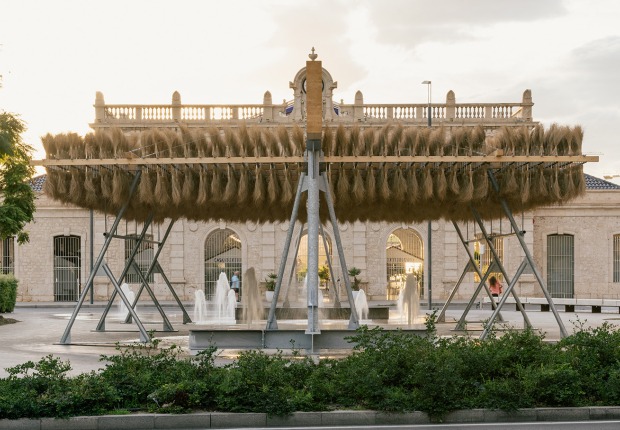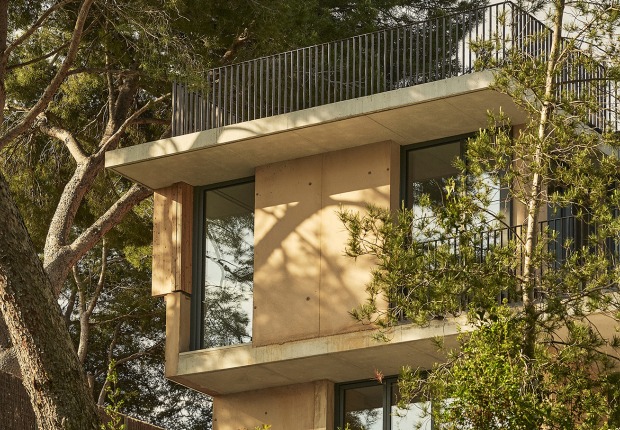At the program level, the building has common spaces on the ground floor and 6 types of housing, two on the ground floor and four on each of the other floors. All of them have spaces for cooking, eating, resting, and washing with good sunlight, double orientations, and cross ventilation.
Its construction is carried out with a single material, the traditional box, either with its natural finish or with a bottle green enameled finish that is used to contextualize the façade with the history of the place, following the modernist and noucentista construction tradition of the houses. summer in Salou.

Transformation of an abandoned building by NUA architectures. Photograph by Jose Hevia.
Project description by NUA architectures
Since the Iberians and Romans, the natural port of Salauris has been a strategic place on the Mediterranean coast from a military, commercial, and, finally, since the second half of the 20th century, tourist point of view.
Essentially a fishing town throughout history, Salou began to receive the first vacationers already in the 19th century thanks to the push of the new industrial bourgeoisie of Reus and the construction of the train, progressively transforming the fishing town into a small spa town. from health and wellness tourism. The construction of several modernist and noucentista houses on the seafront where rooms could be rented at the beginning of the 20th century is the testimony of these first vacationers in search of the therapeutic power of seawater.
For almost 50 years, Salou was growing slowly and timidly in the form of a garden city along its coastline thanks to the success of its spa. However, starting in the 1960s, Costa Dorada, and especially Salou, experienced unprecedented growth due to the tourist development of coastal cities, generating a heterogeneous urban landscape dominated by hotels apartment buildings, and restaurants that coexist with blocks of habitual homes and facilities, forming a mixed and heterogeneous urban context of isolated volumes.
The project orbits around one of these isolated buildings near the sea, initially conceived as a home built on a podium to which floors were added to house a hotel and, since the early 2000s, a nursing home. Dissatisfied with the planning and with volumetry and façade openings unaltered by regulations, the building presented, after 13 years of abandonment, severe signs of degradation and generated public order problems in its surroundings.

Transformation of an abandoned building by NUA architectures. Photograph by Jose Hevia.
Sixty years after the tourism boom in Salou, how should housing for temporary use be considered today and how does tourism have to respond to the social and environmental challenges that we are facing?
The project tries to give new life to the property through its rehabilitation and transformation. The reuse of its architecture before the demolition, the first project decision, presented obvious spatial limitations by having to preserve the existing wall structure and the low free height between slabs, but it allowed for conserving the buildability, adjusting the budget, and a great benefit. for the environment, reducing the carbon footprint of the intervention by avoiding the energy used in demolition, transportation of debris, and construction of new buildings, as well as the generation of waste.
The project is planned as a large house. It aims to escape from the mass tourism model to seek identity in the first vacationers and their hotel residences from the beginning of the 20th century at a conceptual and material level, proposing a temporal dialogue and an alternative life model to mass tourism: a slow, close model. and local, seasonally adjusted, adapted to the Mediterranean climate and rooted in the original architectural tradition of the place, born from spa tourism.
At the same time, as an alternative to the generic and global housing model oriented towards summer vacations and widespread since the 1960s, the new apartments want to be houses, warm, welcoming domestic spaces rooted in the local culture that can be occupied during all year.

Transformation of an abandoned building by NUA architectures. Photograph by Jose Hevia.
In this sense, strategically, it has been taken into account that both the building as a whole and the apartments can meet the regulatory conditions of habitability, so the complex could easily be converted into a permanent residential building at any time. The metamorphosis of the building is the result of a sum of accumulated interventions on the pre-existence, and is divided into four basic strategies:
Consolidate and reorganize.- The first project action aims to rethink the operation of the building and achieve a stable and safe primary structure. The precarious existing wall structure, walls, façade, and slabs have been preserved and reinforced, and the floors have been completely reorganized by adding a second staircase, which is added to an already existing one, and two elevators, forming a surrounding central core that organizes the flow of circulation and allows the housing units to be placed on the perimeter of the façade.
Order and relate.- To improve the habitability of the complex, it is proposed to improve the relationship of the building with the exterior. The existing attic, an uninhabitable space due to its low dimensions in height, has been eliminated, creating a new terrace on the covered floor. At the same time, the side facades have been rethought and organized by opening new windows, the essential ones that the regulations allowed, to achieve lighting and ventilation of all the homes and, in turn, achieve a more unitary urban image, maintaining the existing windows. , more organized, on the front facades. Finally, the existing body on the ground floor has been opened to the outside, which has been transformed into the reception and the restaurant, a gallery connected to the garden that concentrates the accesses, with the generation of a new entrance porch, and allows for generous terraces. in the first-floor apartments.
Isolate and contextualize.- Thirdly, the energy improvement of the property and the search for an identity are proposed. The entire existing volume has been insulated on the outside with a new thermal skin that fulfills, at the same time, a technical function and a conceptual function. This new envelope allows for optimal energy efficiency of the building and, in turn, through the use of ceramics, search for a new identity historically connecting the building with the modernist and noucentista houses of the early 20th century.

Transformation of an abandoned building by NUA architectures. Photograph by Jose Hevia.
Open and naturalize.- Finally, the exterior spaces and the relationship of the building with the city have been rethought. The existing paved exterior terrace has been replaced by a low-maintenance, low-water Mediterranean garden, eliminating the heat island effect, allowing natural drainage of rainwater, and generating shady spaces. The new garden has been opened visually and physically to the public space, achieving accessibility to the building with a new ramp, transforming a hard and rough exterior into a small oasis.
At the program level, the building has collective spaces and technical and service spaces on the ground floor, and 6 types of apartments, two of them on the ground floor, and four on each typical floor. The conception of the apartments, inserted into the existing wall structure, is a concatenation of basic cells that can be made independent or connected, promoting good sunlight, double orientations, and cross ventilation. Thus, all housing units have a space to cook and eat, a space to rest, and a space to wash.
From the point of view of materiality, only one material is used, ceramic, and a single format, traditional rasilla. A single piece in two finish versions that solves all the situations of the project: The tile in a natural finish and the glazed tile in bottle green, which are used to contextualize the façade with the history of the place, following the modernist and noucentista construction tradition. of the summer houses in Salou. A single piece that assumes, at the same time, technical, aesthetic, and symbolic functions and that holistically characterizes the project.
A new life for a forgotten building. A reuse and recycling project that reviews the coastal tourism model by proposing a temporary reconnection with the history of the place.






























































